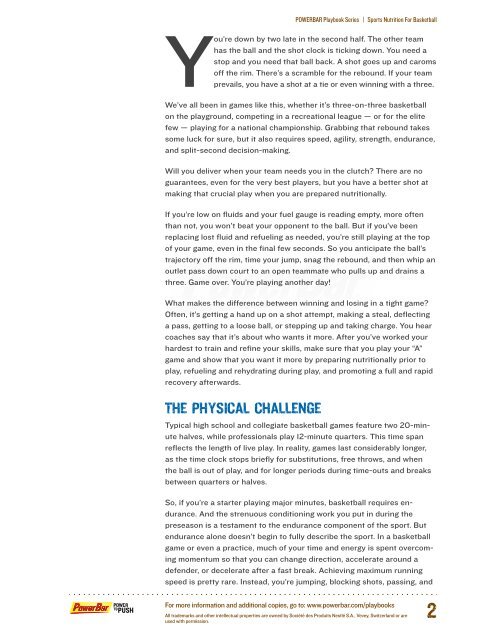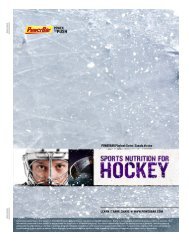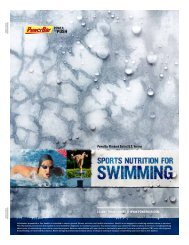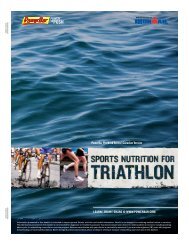POWERBAR Playbook Series | U.S. Version - PowerBar.Com
POWERBAR Playbook Series | U.S. Version - PowerBar.Com
POWERBAR Playbook Series | U.S. Version - PowerBar.Com
Create successful ePaper yourself
Turn your PDF publications into a flip-book with our unique Google optimized e-Paper software.
<strong>PowerBar</strong> <strong>Playbook</strong> <strong>Series</strong> | Sports Nutrition For BasketballYou’re down by two late in the second half. The other teamhas the ball and the shot clock is ticking down. You need astop and you need that ball back. A shot goes up and caromsoff the rim. There’s a scramble for the rebound. If your teamprevails, you have a shot at a tie or even winning with a three.We’ve all been in games like this, whether it’s three-on-three basketballon the playground, competing in a recreational league — or for the elitefew — playing for a national championship. Grabbing that rebound takessome luck for sure, but it also requires speed, agility, strength, endurance,and split-second decision-making.Will you deliver when your team needs you in the clutch? There are noguarantees, even for the very best players, but you have a better shot atmaking that crucial play when you are prepared nutritionally.If you’re low on fluids and your fuel gauge is reading empty, more oftenthan not, you won’t beat your opponent to the ball. But if you’ve beenreplacing lost fluid and refueling as needed, you’re still playing at the topof your game, even in the final few seconds. So you anticipate the ball’strajectory off the rim, time your jump, snag the rebound, and then whip anoutlet pass down court to an open teammate who pulls up and drains athree. Game over. You’re playing another day!What makes the difference between winning and losing in a tight game?Often, it’s getting a hand up on a shot attempt, making a steal, deflectinga pass, getting to a loose ball, or stepping up and taking charge. You hearcoaches say that it’s about who wants it more. After you’ve worked yourhardest to train and refine your skills, make sure that you play your “A”game and show that you want it more by preparing nutritionally prior toplay, refueling and rehydrating during play, and promoting a full and rapidrecovery afterwards.THE PHYSICAL CHALLENGETypical high school and collegiate basketball games feature two 20-minutehalves, while professionals play 12-minute quarters. This time spanreflects the length of live play. In reality, games last considerably longer,as the time clock stops briefly for substitutions, free throws, and whenthe ball is out of play, and for longer periods during time-outs and breaksbetween quarters or halves.So, if you’re a starter playing major minutes, basketball requires endurance.And the strenuous conditioning work you put in during thepreseason is a testament to the endurance component of the sport. Butendurance alone doesn’t begin to fully describe the sport. In a basketballgame or even a practice, much of your time and energy is spent overcomingmomentum so that you can change direction, accelerate around adefender, or decelerate after a fast break. Achieving maximum runningspeed is pretty rare. Instead, you’re jumping, blocking shots, passing, andFor more information and additional copies, go to: www.powerbar.com/playbooksAll trademarks and other intellectual properties are owned by Société des Produits Nestlé S.A., Vevey, Switzerland or areused with permission.2







